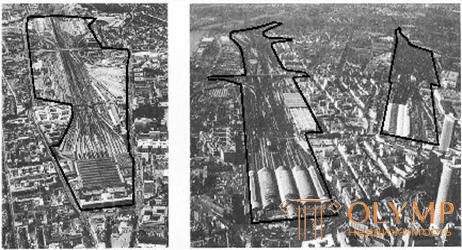
Definition: the external transport serves suburban, local and long-distance passenger and cargo transportation, connects settlements in a single settlement system.
Types of external transport :
• railway;
• automobile;
• air;
• water (river, sea).
Any transport system is characterized by the presence of: transmission channels
(communication lines, highways, sea routes, aviacoridors) and points of reception and dispatch or input-output devices (stations, airports, river ports).
Buildings of external transport can occupy a large area (up to 15% of the city) and have specific features of placement in the structure of the city (Fig. 178).
Railway transport.
The railroad canvass (especially when laying in a hollow or on an embankment) dismembers urban fabric, impedes motor and pedestrian traffic, imposes restrictions on the use of urban areas (sanitary protection zone - 100 m).
Railroad allotment lanes can be considered as a territorial reserve for the reconstruction (expansion and construction of new) transport communications - the surface metro, highways, etc.

Fig. 178. Territories of Munich railway stations (left),
Frankfurt am Main (right)
Air Transport
Due to noise exposure, airports are usually located at a distance from housing (5-10 km depending on the class of the airport). Air terminals (ground passenger services, check-in, etc.) are divided into central, eccentric and peripheral depending on the position in the city structure.
Water transport
River and sea, functioning is limited by seasonality and configuration of the rivers, cargo ports occupy large areas, in large historical cities often prevent the center from reaching the river.
Automobile transport
The most dynamically developing mode of external transport at the moment is characterized by variability, off-seasonality, maneuverability, speed. In the future - the formation of a unified system of highways.
In the structure of the city, high-speed motorways and multi-level junctions can occupy large areas (Fig. 179).

Fig. 179. Road junctions and highways in major cities
High-speed motorways try to route around cities or tangentially to them in order to avoid the transit of motor vehicles and the dismemberment of the city by highways (Fig. 180).

Fig. 180. Bypass Highways, Spain
Perspective types of external transport are considered: pipeline, suspended
(monorail, string), magnetic, air cushion, etc. (Fig. 181)

Fig. 181. Non-public, elevated transport (monorail, string, suspended)
Что бы оставить комментарий войдите
Комментарии (0)